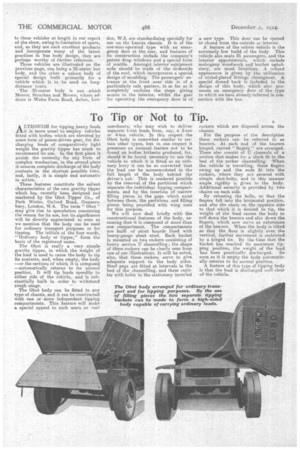To Tip or Not to Tip.
Page 24

If you've noticed an error in this article please click here to report it so we can fix it.
ALTHOUGH for tipping heavy loads it is more usual to employ vehicles fitted with bodies which are elevated by some form of power-driven gear, for discharging loads of comparatively light weight the gravity tipper has much to recol-nmend its use. In the first place it avoids the necessity for any form of complex mechanism, in the second place it. ensures complete discharge of the body _contents in the shortest possible time, and, lastly, it is simple and automatic
in action. .
These features constitute the salient characteristics of the new gravity tipper which has recently been designed and marketed by the Obot Tipper Co., of Park Works, Oxford Road, Gunners. bury, London, W.4. The term" Obot" . may give rise to speculation concerning the reason for its use, but its significance will be directly appreciated so soon as we mention that the body can be used for ordinary transport purposes or for tipping. The initials of the four words, "Ordinary body or tipper," form the basis of the registeredname.
The Obot is really a very simple gravity tipper, in which the weight of the load is used to cause the body to tip its contents, and, when empty, the body —or the sections of which it is composed —automatically returns to its normal position. It will tip loads speedily to either side of the vehicle, and is substantially built in order to withstand rough usage.
The Obot body can be fitted to any type of chassis, and it can be constructed with one or more independent tipping compartments. This feature will make a special appeal to such users as coal merchants, who may wish to deliver separate 1-ton loads from, say, a 3-ton or 4-ton vehicle. In this respect. the Obot body is somewhat similar to certain other types, but in one respect it possesses an unusual feature not to be found on betties hitherto produced, for, should it he found neceSsary to use the vehicle to which it is fitted as an ordinary lorry it can be so converted that the load can be accommodated in the full length of the body behind the driver's cal. This is rendered possible by the removal of the partitions which separate the individual tipping compartments and by the insertion of narrow filling pieces in the gaps which exist between them, the partitions and filling pieces being provided with wing nuts for this purpose.
We will now deal briefly with the constructional features of the body, assuming that it is composed of more than one compartment. The compartments are built of stout boards lined with heavy-gauge sheet steel. Each bucket is mounted On two rockers consisting of heavy section U channelling ; the shape of these rockers can be clearly seen from one of our illustrations. It will he noted, also, that these rockers serve to give adequate support to the body sides. Steel pegs are fitted at intervals in the bed of the channelling, and these register with holes in the stationary inverted
rockers which are disposed across the chassis.
For the purpose of the description these rockers can be referred to as bearers. At each end of the bearera hinged, curved " fingers" are arranged. These also consist of U channels of a section that makes for a slack fit in the bed of the rocker channelling. When the vehicle is travelling, these fingers swing up and the ends fit into the rockers, where they am o secured with simple shot-bolts, and in this manner ample rigidity is given to the body. Additional security is provided by two chains on each side.
By releasing the bolts, so that the fingers fall into the horizontal position, and also the chain on the opposite side to that which it is desired to tip, the weight of the load causes the body to roll down the bearers and also down the fingers, which now serve aS extensions of the bearers. When the body is tilted SO that the floor is slightly over the vertical, further movement is restricted by a hinged tie. By the time that the bucket has reached its maximum tipping position, the weight of the load has been practically discharged. So soon as it is empty the body automatically returns to its normal position.
A feature of this type of tipping body is that the load is discharged well clear of the vehicle.
































